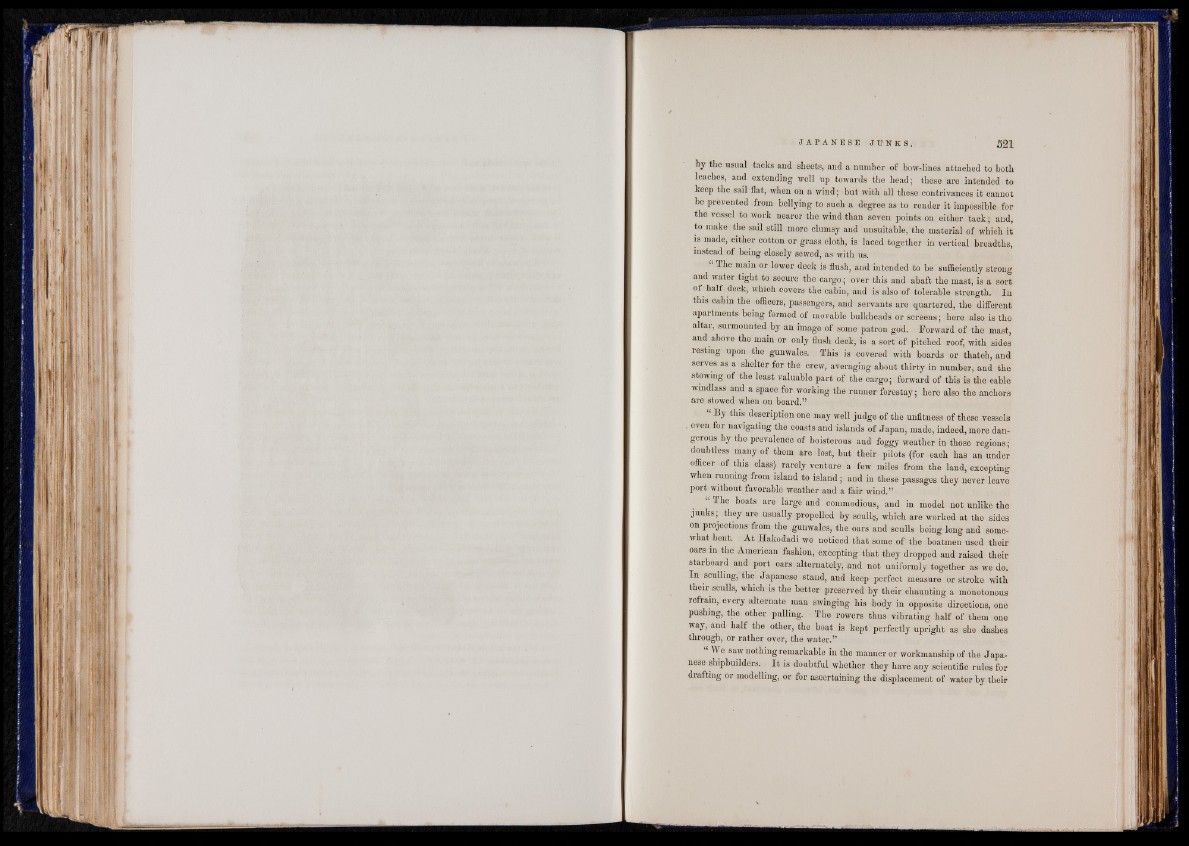
J A P A N E S E J U N K S .
by the usual tacks and sheets, and a number of bow-lines attached to both
leaches, and extending well up towards the head; these are intended to
keep the sail flat, when on a wind; but with all these contrivances it cannot
be prevented from bellying to such a degree as to render it impossible for
the vessel to work nearer the wind than seven points.on either tack; and,
to make the sail still more clumsy and unsuitable, the material of which it
is made, either cotton or grass cloth, is laced together in vertical breadths,
instead of being closely sewed, as with us.
The main or lower deck is flush, and intended to be sufficiently strong
and water tight to secure the cargo; over this and abaft the mast, is a sort
of half deck, which covers the cabin, and is also of tolerable strength. In
this cabin the officers, passengers, and servants are quartered, the different
apartments being formed of movable bulkheads or screens; here also is the
altar, surmounted by an image of some patron god. Forward of the mast,
and above the main or only flush deck, is a sort of pitched roof, with sides
resting upon the gunwales. This is covered with boards or thatch, and
serves as a shelter for the crew, averaging about thirty in number, and the
stowing of the least valuable part of the cargo; forward of this is the cable
windlass and a space for working the runner forestay; here also the anchors
are stowed when on board.”
By this description one may well judge of the unfitness of these vessels
. even for navigating the coasts and islands of Japan, made, indeed, more dangerous
by the prevalence of boisterous and foggy weather in those regions;
doubtless many of them are lost, but their pilots (for each has an under
officer of this class) rarely venture a few miles from the land, excepting
when running from island to island; and in these passages they never leave
port without favorable weather and a fair wind.”
The boats are large and commodious, and in model not unlike the
junks; they are usually propelled by scull§, which are worked at the sides
on projections from the gunwales, the oars and sculls being long and somewhat
bent. At Hakodadi we noticed that some of the boatmen used their
oars in the American fashion, excepting that they dropped and raised their
starboard and port oars alternately, and not uniformly together as we do.
In sculling, the Japanese stand, and keep perfect measure or stroke with
their sculls, which is the better preserved by their chaunting a monotonous
refrain, every alternate man swinging his body in opposite directions, one
pushing, the other pulling. The rowers thus vibrating half of them one
way, and half the other, the boat is kept perfectly upright as she dashes
through, or rather over, the water.”
“ We saw nothing remarkable in the manner or workmanship of the Japanese
shipbuilders. I t is doubtful whether they have any scientific rules for
drafting or modelling, or for ascertaining the displacement of water by their